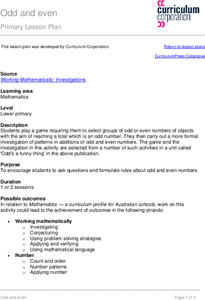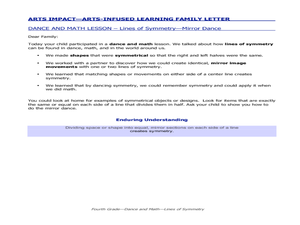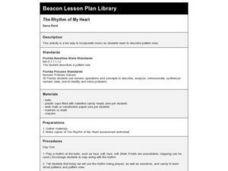Curated OER
The Fibonacci Sequence
Students investigate a numerical pattern and look for evidence of mathematical patterns in nature. They solve puzzles and work with a partner to predict sequential numbers in a series.
Curated OER
Roman Numeration
Gain a deeper understanding of the base 10 system through practicing conversion to Roman numerals through one million. The class is taught how to read the numerals through modeling and guided practice. This lesson includes a homework...
Curated OER
Interpreting Graphs
Sixth graders interpret linear and nonlinear graphs. They create graphs based on a problem set. Next, they represent quantitive relationships on a graph and write a story related to graphing.
Curated OER
Fabulous Fractals
Students view a video to discover how patterns in nature relate to math. They explore the concept of exponential growth by observing and creating fractals. They solve and design word problems.
Curated OER
Investigation - Looking For Triangles
Seventh graders investigate a series of triangles, looking for patterns and generalizing what they have found. They analyze the pattern data and organize it into a table and graph. Students identify the relationship and discover the rule...
Curated OER
Writing Variable Expressions for Physical Models
Explore the concept of writing variable expressions by examining the similarities between expressions with numbers and expressions with variables. Emerging mathematicians determine rules for sequences and patterns before writing a rule...
Curated OER
Transformations Using the Geometer's Sketchpad
Students discover rules for single transformations, rules for composition of transformations, when a figure has transformation symmetry, and if a transformation is congruent to its preimage.
Curated OER
Odd and even
Learners play a game requiring them to select groups of odd or even numbers of objects with the aim of reaching a total which is an odd number. They carry out a more formal investigation of patterns in additions of odd and even numbers.
Curated OER
Exploring Roman Numerals
Students investigate the values of a variety of Roman Numerals and compare and contrast the patterns with Arabic numbers. The application, "Numerus" is utilized to lead students through the lesson.
Curated OER
Lining Up the Cars
Students review how to count the total amount of arrangements using multiplication. Using a computer, they determine the amount of cars needed for a parade in their local community to move the town's officials. They identify any patterns...
Curated OER
Lines of Symmetry - Mirror Dance
Fifth graders analyze how to divide space or shape into mirror sections to create lines of symmetry. In this lines of symmetry lesson, 5th graders discuss symmetry in dance, math, and living. Students participate in a dance warm-up and...
Curated OER
Add It Up In Number Ville! Adding 2-Digit Numbers With and Without Regrouping
Students explore adding 2-digit numbers. In this math lesson, students identify 2-digit numbers and use base ten blocks to practice adding. Students use addition to break a code.
Curated OER
Worksheet 34 - Sequence
In this sequence worksheet, students examine sequences, write the terms of a sequence, identify the limits of a sequence. This one-page worksheet contains seven problems.
Curated OER
Pascal's Triangle
In this math worksheet, students read the discussion about the importance of games. They create a game as directed. They also read the rules for the Pascal Triangle.
Curated OER
Solving a Legend- Exponents, Recursive and Explicit Equations.
Eighth graders play a game to solve problems. In this exponents and scientific notations lesson, 8th graders play a game in small groups to move colored disks from location A to location C. Students identify recursive patterns to solve...
Curated OER
Graphing Linear Functions
Seventh graders identify the use of a function.They are asked to describe the input and output of a function. Students also identify different aspects of the coordinate system and represent functions in a visual graph.
Curated OER
Pascal's Triangle
Fourth graders explore the patterns of Pascal's Triangle. In this problem solving lesson plan, 4th graders identify the patterns in the triangle by using the elements and the rule of the triangle.
EngageNY
Recursive Formulas for Sequences
Provide Algebra I learners with a logical approach to making connections between the types of sequences and formulas with a lesson that uses what class members know about explicit formulas to develop an understanding of...
Curated OER
In and Out Function
Third graders examine how to solve in and out function problems, or mystery numbers. They analyze a variety of mystery number problems together and extend the patterns. Students then independently complete a Mystery Number activity...
Curated OER
Sequences and Exponents
Young scholars practice multiplication sequences and multiplying with exponents. They study how a sequence is a set of numbers which follows a mathematical rule and can be used with all four operations and with combinations of operations.
Curated OER
Basic Counting Principle
Students find the number of possible arrangements of several objects by using the Basic Counting Principle. In this math lesson, students divide into groups and determine the number of possible sandwiches which can be made given certain...
Curated OER
The Rhythm of My Heart
First graders describe pattern rules. They use the rhythm being played on a bell and candy hearts to explore patterns and pattern rules. This is an especially good instructional activity to use around Valentine's Day.
Curated OER
Belongs, Doesn't Belong
Fifth graders discover the rule used to sort a set of data into two sets, those data that belong according to the rule and those data that don't belong. Students participate in a game to determine the rule. They discuss strategies for...
Curated OER
Cannon Balls
Second graders investigate 2 and 3 dimensional objects. They discuss the characteristics of the triangle. Students create sequential patterns and describe the rule for their pattern.























